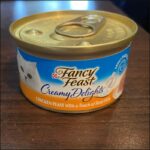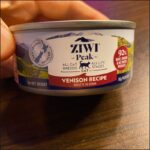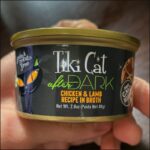Disclaimer: As a Chewy and Amazon affiliate, I earn from qualifying purchases. This does not impact our comparisons.
I’ve looked at over 50 popular cat foods to find what’s best for senior cats.
Fancy Feast Creamy Delights stood out for senior cat health. It’s packed with animal protein and calories to support ageing cat health.
Here’s my 3 best wet cat food for senior cats (scroll down for a full list):
Cats are considered seniors at the ripe old age of 10.
It’s not all sunshine and rainbows, as cats at this age can suffer from sarcopenia, which results in loss of strength and mobility.
To combat this, you’ll want to choose a high protein and calorie diet. Unfortunately, many foods just don’t cut it.
Not to worry, as I’ll offer my 7 best cat foods for senior cats and a buying guide to help know what to look for.
Then I’ll go through frequently asked questions on the top of senior cat care.
If you want to find what is absolutely the best for your cat, then read on…
As a dietitian, I have a background in researching nutrition for humans, but am also a cat nutrition enthusiast.
Where possible, I’ve hand tested these products.
Whilst I am not a veterinarian, I have taken every effort to ensure I’ve pick suitable options that meet research best practices for senior cat health.
Please note that this article is not intended as a replacement for medical advice.
>> Learn More on our About Page
7 Best Wet Cat Food for Senior Cats Choices Ranked
Using a database of popular cat foods, I filtered options that meet the needs of senior cats.
I included cat foods with:
- More than 40% protein (dry basis)
- More than 4.0 kcal/g
- Cat food suited for growth or all life stages*
- (preferably) Pate texture for easy chewing
*Growth and all life stages mean the same thing, but used in different contexts.
From those options, I sorted the remaining options based on how well they scored overall on the following criteria:
- Price
- Ingredient quality
- Nutrition
- Flavor
- Customer rating
To help with comparison, I’ve displayed scores visually. This helps you get a quick snapshot of a cat foods strengths and weaknesses.
To learn more about how I calculate and grade food, check out our review guidelines.
Best Budget Wet Cat Food for Senior Cats
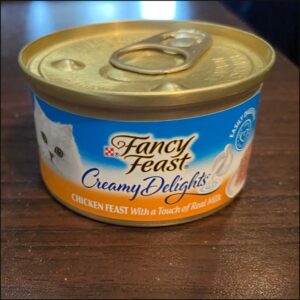
Fancy Feast scores well across the board, and it’s an easy choice for seniors as it’s suitable for all life stages.
Reliable on a budget, with an easy-to-chew pate which is helpful for seniors with dental issues.
My main gripe is the inconsistent quality from tin-to-tin (unlike Ziwi Peak). Some tins smell more and my cats walk off.
Meat rich pate
Complete for all ages
High calorie for weight loss
Inconsistent flavor
Some tins smell
Healthiest Wet Cat Food for Senior Cats
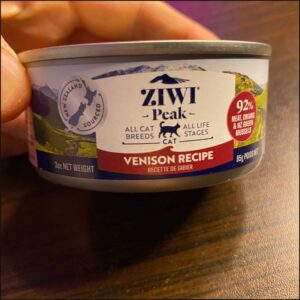
Ziwi Peak contains named meat ingredients, which provides better taste and nutrition consistency from tin to tin.
Our cats enjoyed the easy-to-chew pate with it’s rich meaty taste. They also offer novel protein choices for allergies.
Main downsides are the price and added chickpeas, a lower quality protein source.
92% animal protein
Easy-to-chew pate
High calorie for weight loss
Pricey
Added chickpea
Best Senior Wet Food for Sensitive Stomachs
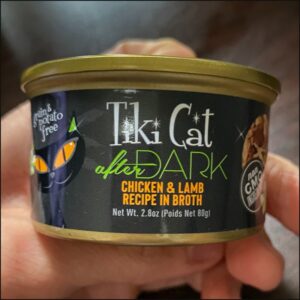
If you’re trying to help a senior with a sensitive stomach you’ll need a limited ingredient cat food without fillers.
And the best available option for that is Tiki Cat After Dark. It’s almost 100% meat and organs in a tin and is a complete meal for all life stages.
The price is the main problem. The shredded texture might not suit some and skinny seniors might need a higher calorie option (although it’s great for overweight cats).
Grain and soy free
No added gums
Complete for all ages
Pricey
Bit low on calories
Best Dry Cat Food for Older Cats
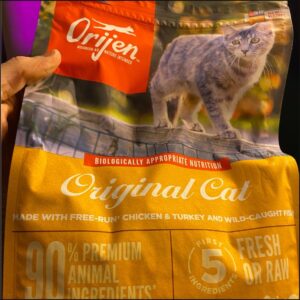
Orijen is a good all-round choice. It’s complete for all ages with a high protein and calorie content to help older cats gain weight.
It’s got an impressive array of meat ingredients in the bag, which are the best sources of protein. The small discs is easier to bite into than other kibble.
Like all dry cat food, the water content makes this less ideal for urinary health. Our kittens had mixed feelings about it and they could have more sizes to choose from.
Small round disc shape
High protein for strength
Complete for all ages
Mixed taste (my experience)
Lacks moisture
Best Wet Cat Food for Senior Cats With Kidney Disease
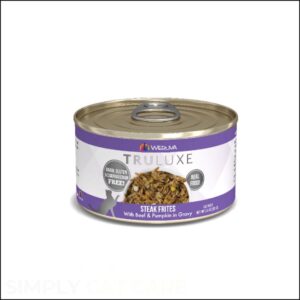
For kidney disease, you’ll want to keep phosphate down. Weruva Truluxe steak frites is one the lowest non-prescription cat foods for phosphate.
The food comes in human grade shreds of real meat. The protein content is high (61%) which helps cats maintain strength.
The quality is held back a little by starchy ingredients like sweet potato (not required in a cats diet). The calorie content is a tad low and protein might be too high for late stage kidney disease.
Low phosphate
Human grade shreds
High protein for strength
Added sweet potato
Kidney stage specific
Best Senior Cat Wet Food for Weight Gain
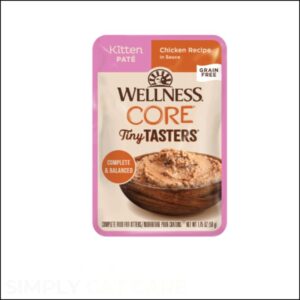
Although intended for kittens, this is one of the highest calorie choices (1,400 kcal/kg) making it an excellent choice for struggling skinny seniors that need help maintaining weight.
Comes in an easy-to-chew pate and has a mix of chicken, tuna, and duck – all high quality protein options for strength.
The price is the only real downside.
High calorie for weight gain
Easy-to-chew pate
Great meat ingredients
Very pricey
Added gums
Best Vet Recommended Senior Cat Food
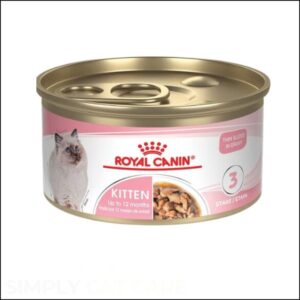
Of all the brands you’ll see lining the vet shelves, Royal Canin is our best rated choice for senior health.
Again, you’ll notice I’ve opted for the kitten choice because it offers more protein to help seniors maintain strength and help tackle lost appetite.
The added wheat gluten (low quality protein) and carrageenan (may irritate digestion) bring down the ingredient score.
Best of the vet choices
High protein for strength
Great for picky eaters
Added wheat gluten
Added carrageenan
What Should I Look for When Choosing Wet Food for My Senior Cat?
High protein and calorie wet food is best for senior cats.
Cats are seniors at 10 years old. Senior cats have a harder time digesting protein & fat.
Many senior cats lose weight to sarcopenia (age related muscle loss). This is why a high protein and calorie diet is best.
There are no dietary guidelines for senior cats. That means there’s no cat food for seniors, including those marketed for them on the label.
Here are more tips for senior cats:
Choose High Calorie Cat Food
Increasing calories can help senior cats maintain weight.
Older cats have worsened protein and fat digestion. Bumping up calories helps manage this problem.
Decrease calories if your older cat is overweight (less common in older cats). Use a body condition chart (BCS) to know if your cat is under or overweight (see here).
Specific recommendations suggest a cat food with 4-4.5 kcal/g dry matter. Most cat food (aside from some very low fat products) meet this.
Quick notes:
- Older cats have impaired protein and fat digestion.
- Bumping up calories helps tackle weight loss.
- Aim for at least >4 kcal/g (dry basis).
Choose High Protein Cat Food
A high protein diet helps treat muscle loss in older cats.
30% of senior cats over 12 years have impaired protein digestion. Muscles need protein, so less digestion is going to make it harder for older cats to keep muscle on.
Experts recommend opting for wet cat food with over 40% protein (dry matter). This helps senior cats maintain strength and compensates for reduced digestion.
To find out if your cat food has enough protein, use an online calculator. Use the nutrition or guaranteed analysis and pop that into the calculator.
Need more help?
Here’s an example using Meat Mates wet cat food (see website). First, I need the guaranteed analysis (see below).
- Protein: 7.5%
- Fat: 7.5%
- Carbohydrate: 0.3%
- Fiber: 0.7%
- Ash: 2.0%
- Moisture: 82.0%
Since the calculator doesn’t have ash and carbohydrate, combine the two and put it into ‘others’ (adds up to 2.3%). You need to get everything to add up to 100%.
Based on the dry matter calculation, Meat Mates has a 41% protein (dry basis). This means it’s suitable for senior cats.
Quick notes:
- Senior cats tend to lose muscle which decreases strength.
- Experts suggest a target of 40% protein (dry basis).
- This will help your senior cat maintain muscle.
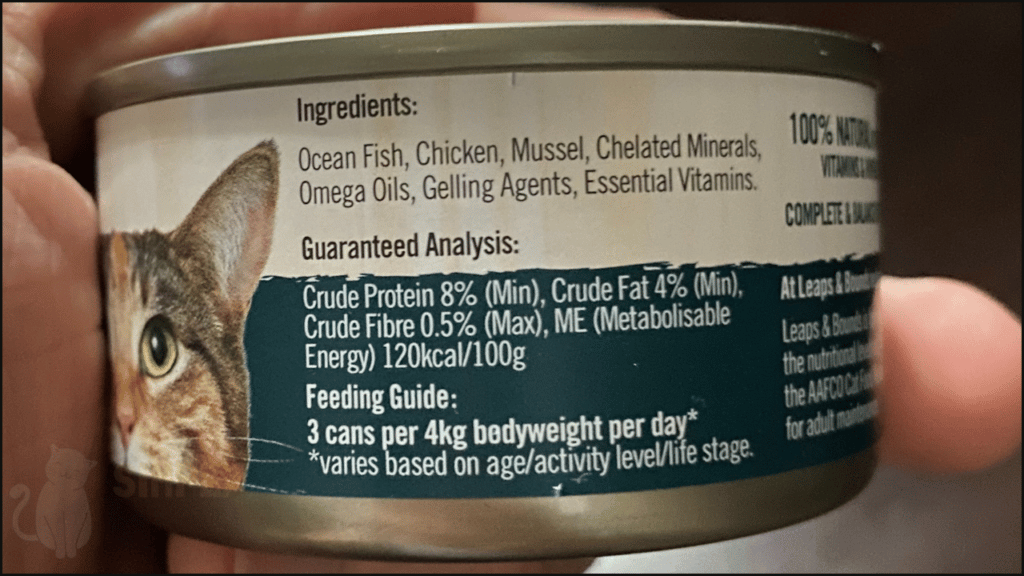
Choose Cat Food High in Animal Protein
Animal protein is easier for senior cats to digest.
Grain based ingredients reduce the digestibility of protein. Cooked mashed corn also impairs fat and protein digestion.
Corn protein increases the risk of constipation and urinary tract disorders. Not great, since senior cats have a higher risk of constipation.
Steer clear of grain based protein ingredients like wheat and corn gluten. These are low quality protein ingredients that aren’t great for older cats.
Quick notes:
- Animal protein is easier to digest.
- Grain protein impairs fat and protein digestion.
- Better quality protein = better results.
Choose Low Carb Cat Food
Cats have no need for carbs in the diet as obligate carnivores.
Experts suggest a diet with less than 15% carbs (dry basis) to improve health markers in diabetic cats. Senior and obese cats are at higher risk of diabetes.
A lower carbohydrate diet can also prevent your cat gaining weight from fat. Use this online calculator to find out how much is in your cat food.
Quick notes:
- Cats are obligate carnivores.
- A low carb diet is helpful for diabetic and obese senior cats.
- Aim for cat food with less than 15% carbs (dry basis) in these cases.
Choose Kidney Friendly Cat Food
As senior cats are at higher risk of kidney disease, you want to be mindful of their food. Over 31% of cats over 15 years affected.
Aim for a >1:1 ratio of calcium to phosphate. This helps reduce phosphate absorption and helps reduce damage to the kidneys.
In humans, a low calcium and high phosphate diet increase the risk of mortality. It seems that the ratio of calcium to phosphate not phosphate itself is of most importance in health.
Quick notes:
- Over 31% of cats over 15 have kidney disease.
- A high calcium and low phosphate diet may help protect the kidneys.
- Speak with your vet for more advice at this age range.
Choose Complete Cat Food
Whilst AAFCO don’t set guidelines for senior cats, you still want ‘complete’ cat food. This means cat food designed to as a sole dietary source, and not a supplemental one.
Look for the statement of nutritional adequacy for all life stages or growth. This is best suited for the nutrition needs of senior cats.
This information is usually listed on the package.
Quick notes:
- Look for the statement of nutritional adequacy.
- For senior cats, choose food suited to either ‘all life stages‘ or ‘growth‘.
- Both terms effectively mean the same and offer more nutrition quality.
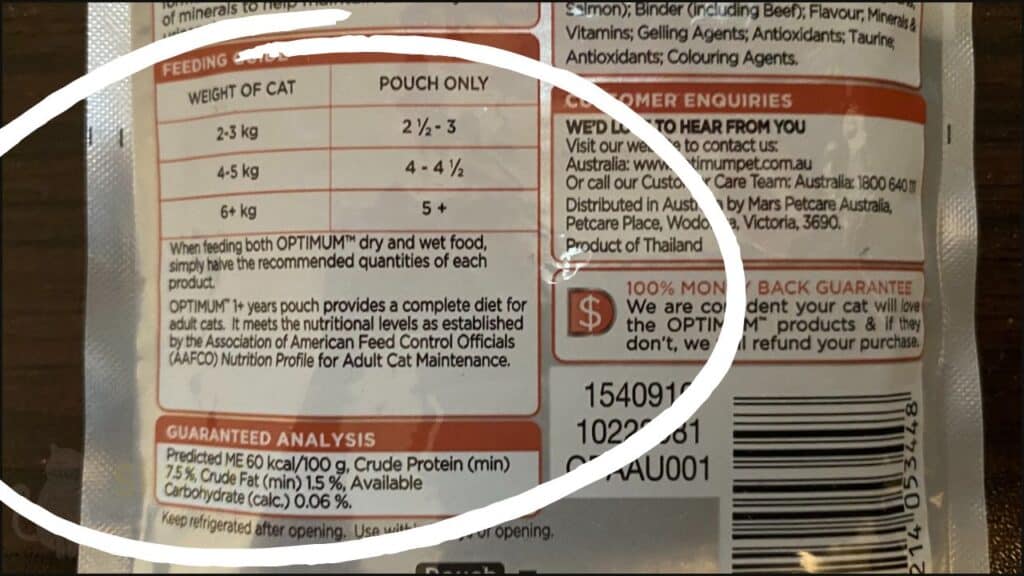
Do Senior Cats Need Senior Food?
There is no criteria for nutrition attached to the word ‘senior’ on a cat food label.
According to a vet:
“There is no AAFCO designation for a ‘senior’ diet, nor is there a nutrient profile for a senior cat,” he says. “Therefore, ‘senior’ diets are essentially slightly modified adult foods.”
Joseph Bartges, DVM, Ph.D., DACVIM, DACVN
Mature wet cat foods contain less protein, with more fiber. The calorie content is inconsistent in mature foods.
The problem is older cats tend to get categorized a few ways. Mature cats tend to gain weight, whilst seniors lose weight (after 12 years).
Kitten food may be a better choice for senior cats. This is because kitten food is higher in protein and fat, with added calcium.
Quick notes:
- ‘Senior cat food’ is a marketing term.
- Some of these foods aren’t ideal for senior cats (less protein, more fiber).
- Kitten food may be better for seniors since it has more protein.
Should Senior Cats Eat More Wet Food?
Yes, wet cat food is a great option for senior cats.
This type of food is easy to chew and helps with muscle loss. It also provides moisture for hydration.
Researchers suggest wet food with the following for senior cats:
- High calorie (>4.5kcal/g)
- High protein (>40% dry matter)
- Animal ingredients for easy digestion
Frequently Asked Questions
Conclusion
Cats are seniors at 10 years of age.
A senior cat is at risk of age related muscle loss among other conditions like kidney disease and diabetes. High protein diets help to combat muscle loss.
It’s generally best to go with an easy-to-chew pate style food for senior cats. This is a more manageable and helpful for cats with dental issues.
Top Recommendation: Our best choice for senior cats is Fancy Feast Creamy Delights. It’s high in protein and calories to tackle weight loss.
Further reading:

